UX Case Study:
EFFECTIVELY
The DBT App
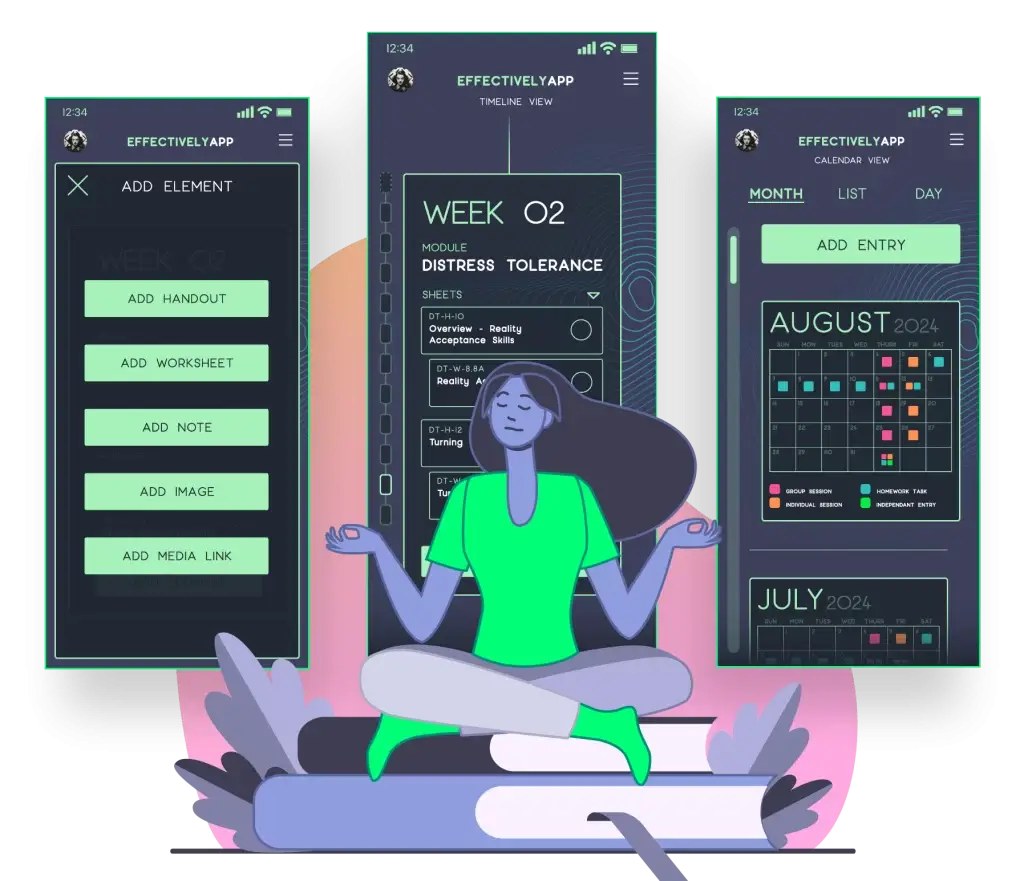
EFFECTIVELY
is a mobile therapy tracker designed for precision planning and deep learning in support of professional and self-directed DBT: Dialectical Behaviour Therapy.
Table Of Contents
Discovery & Definition ↴
Development & Delivery ↴
Discovery &
Definition
The mental health apps market had a valuation of USD 5.1 billion in 2022 and is projected to reach USD 17.1656 billion by 2030, growing at a compound annual growth rate (CAGR) of 16.1% during the forecast period from 2023 to 2030, according to SNS Insider.
Business Insider. September 21, 2023
What Is DBT?
Dialectical Behaviour Therapy (DBT) is a practice-based behavioural therapy, organized and delivered much like an academic course.
Tap the Boxes to Expand or Collapse the Section
Origins of DBT
In the 1980s, Dr. Marsha Linehan rose to the enormous challenge of supporting clients who had many of the hallmark symptoms of complex post-traumatic stress.
These clients frequently experienced overwhelming thoughts and emotional pain, accompanied by a variety of maladaptive coping behaviours and core beliefs. Common threads were identified, including the overwhelming fear of real and/or perceived abandonment, and a tendency to self-harm as a tool for reducing emotional pain.
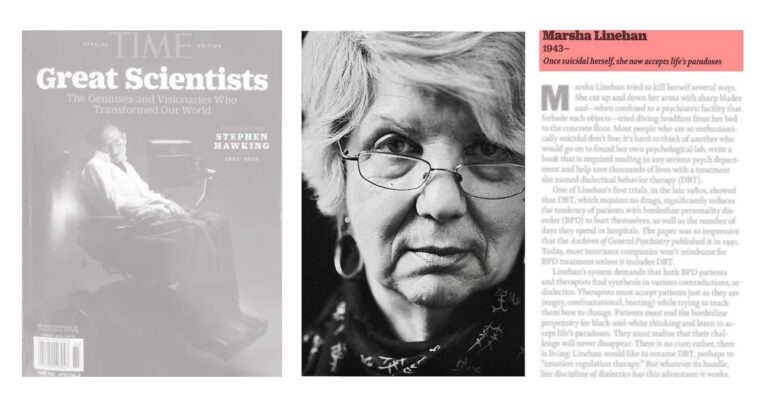
For Dr. Linehan, it’s personal; the creator of Dialectical Behaviour Therapy shares a diagnosis with many of her earliest clients.
Borderline Personality Disorder is a highly stigmatized condition described in the Diagnostic & Statistical Manual of Mental Illnesses, 5th Edition (DSM-5). Many of the patients who initially arrived in front of Dr. Linehan had been diagnosed with the disorder, and most often had been discharged by previous private clinicians due to the intensity of their emotions and behaviours.
Dr. Linehan created an evidence-based system for understanding and regulating intense emotion, for validating thoughts and for restructuring target behaviours.
The scope of DBT’s target treatment population has expanded over time; ongoing research reveals its ability to help alleviate symptoms of persistent emotional distress associated with a variety of other psychiatric conditions described in the DSM-5.
Dr. Linehan describes the therapy as synthesizing two essential components:
Technology of acceptance
Technology of change
A significant barrier to increasing widespread access to this transformational therapy is its cost of operation.
Significant responsibility and requirements for care are placed on the teams of clinicians who deliver DBT programming at its intended capacity; the standards for access to support are extended to the clinicians themselves in addition to the clients of the therapy.
Structure of DBT
Clients study and practice from a textbook containing Handouts and Worksheets. The therapy lasts from six months to one year. There are five learning modules:
Mindfulness & Wisemind
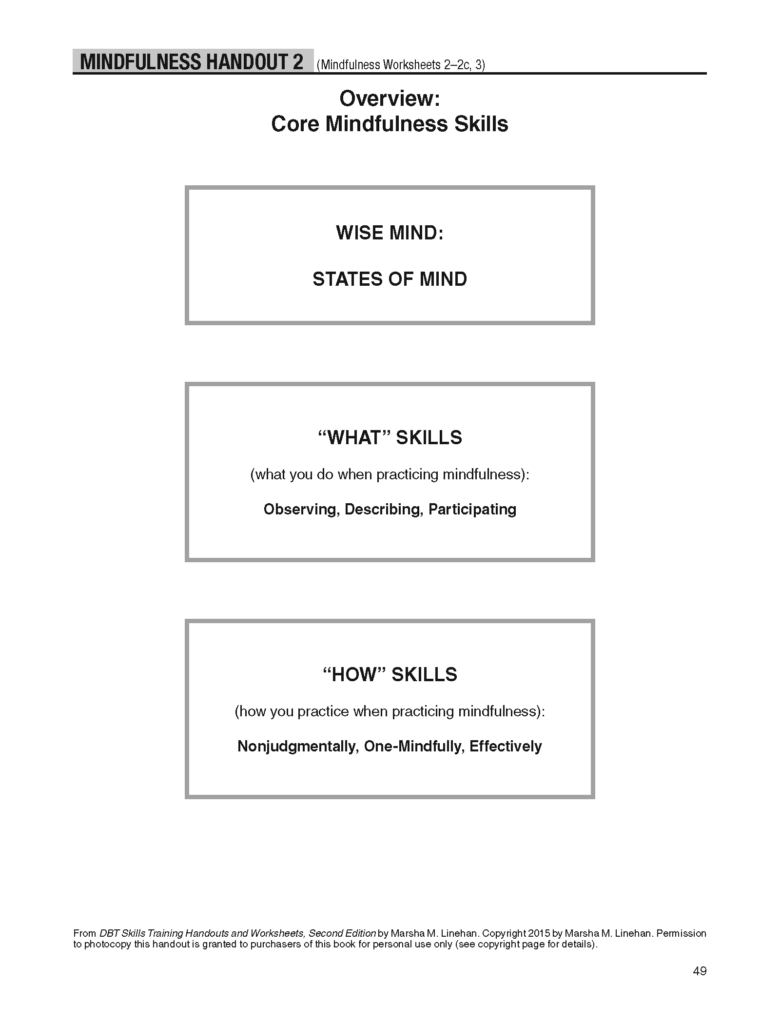
Interpersonal Effectiveness
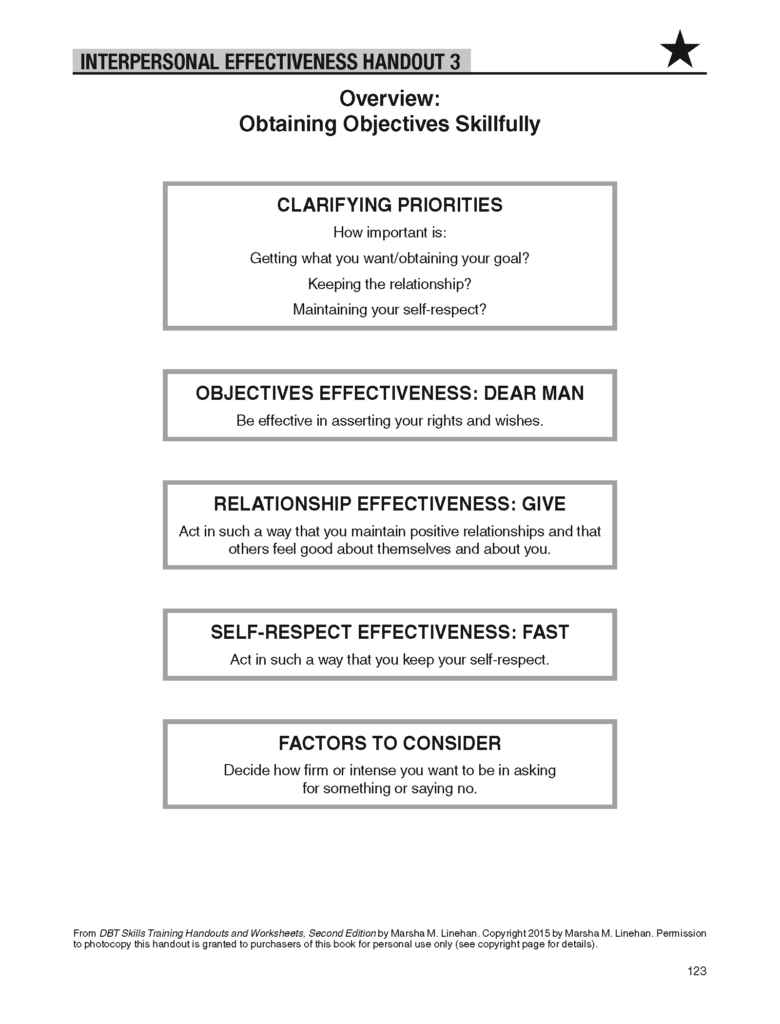
Emotion Regulation
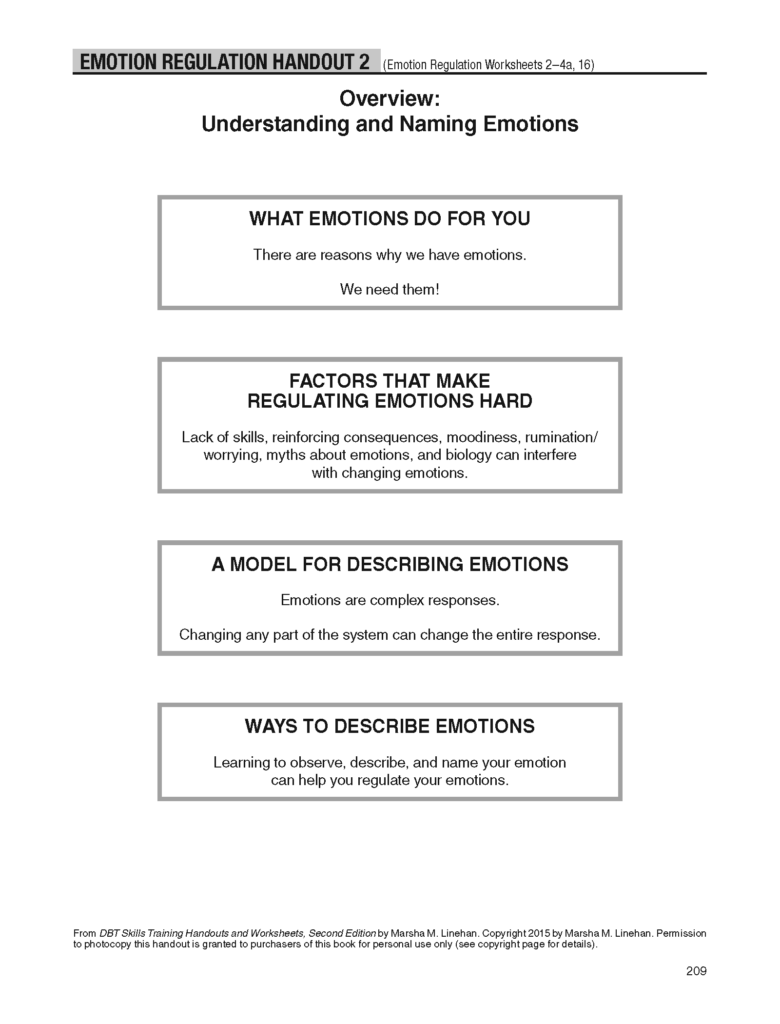
Distress Tolerance
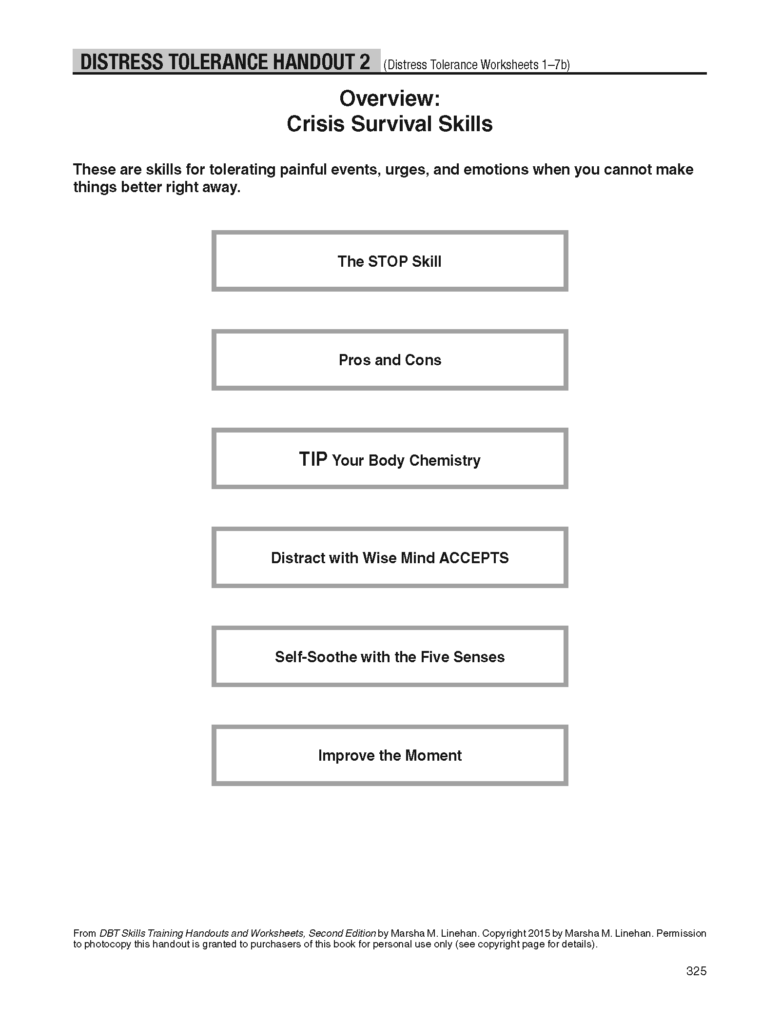
General Skills
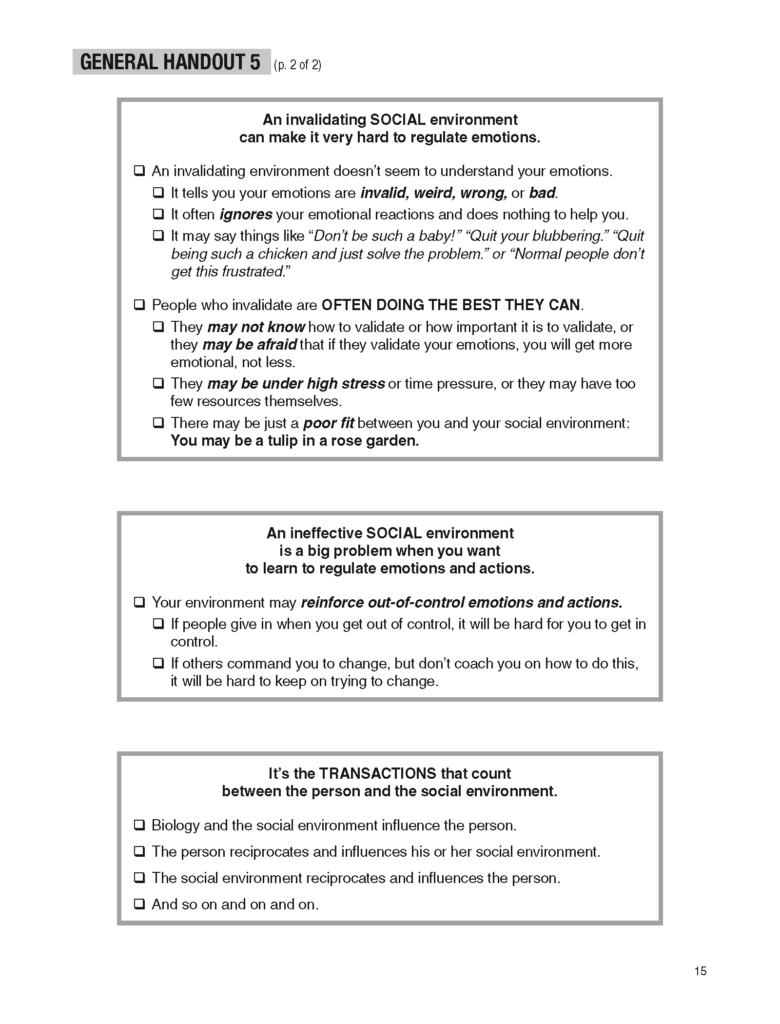
Literature Review
Efficacy of Mobile Therapy Apps
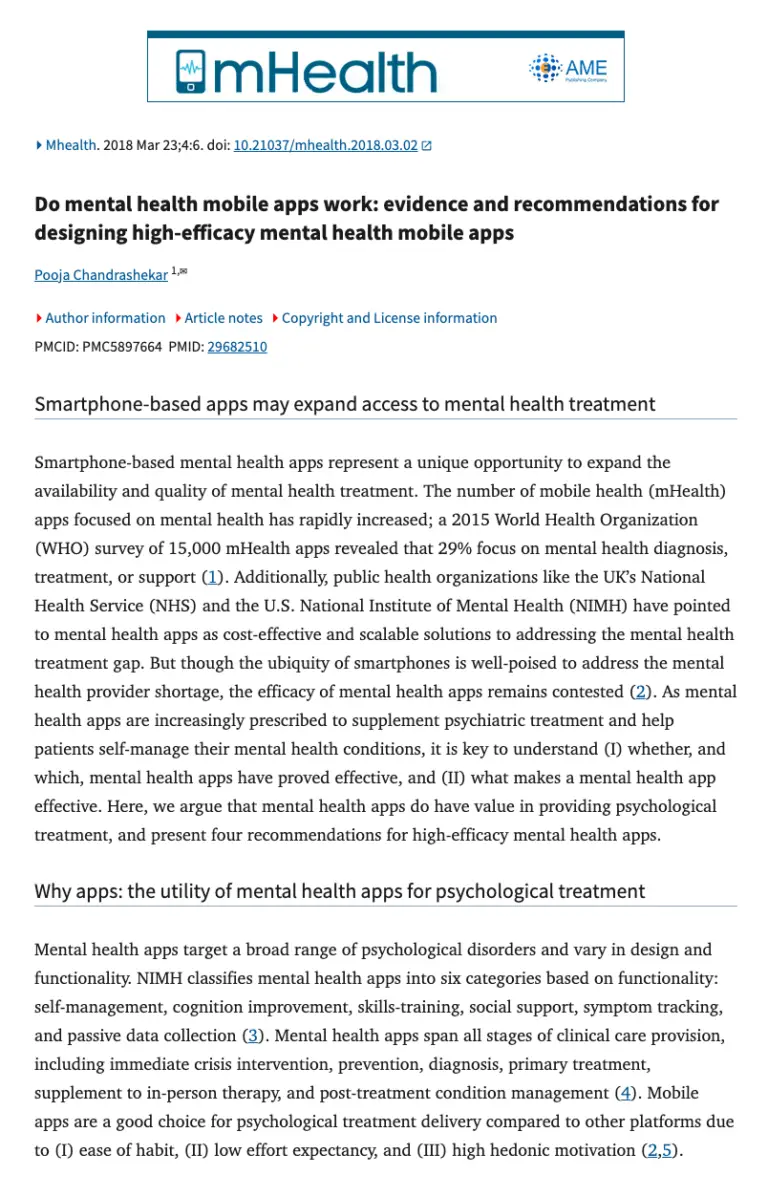
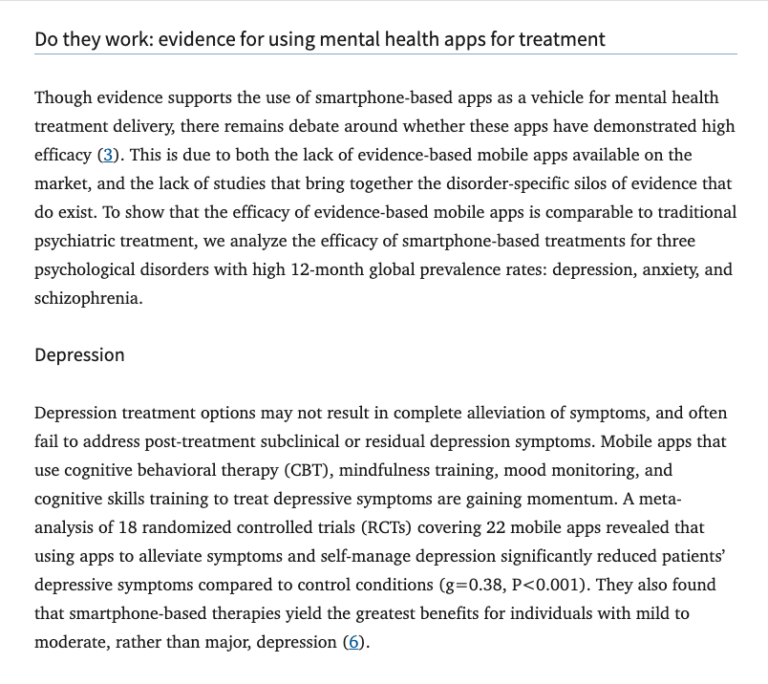
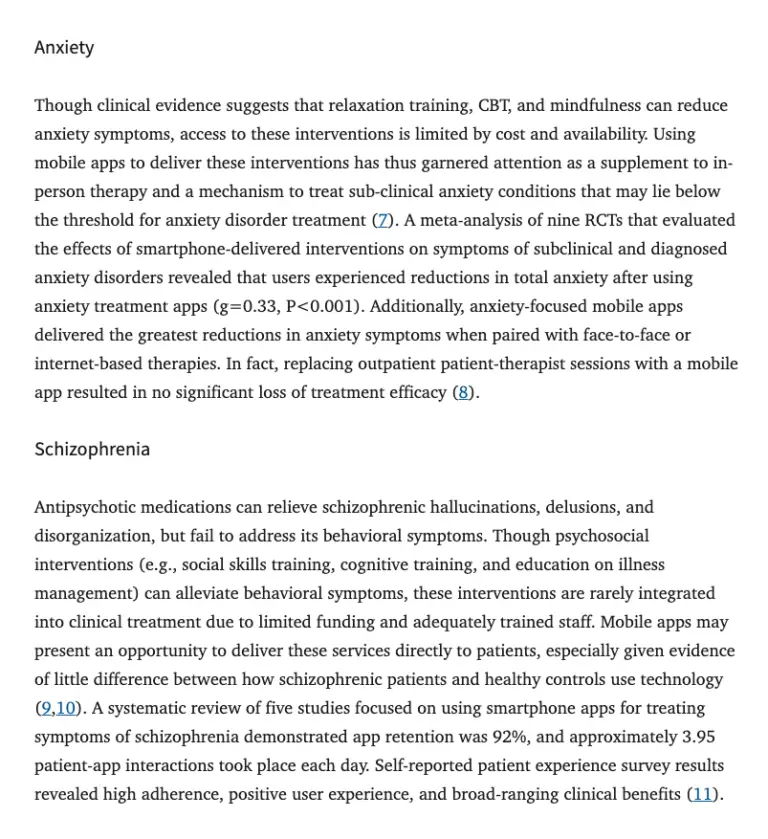
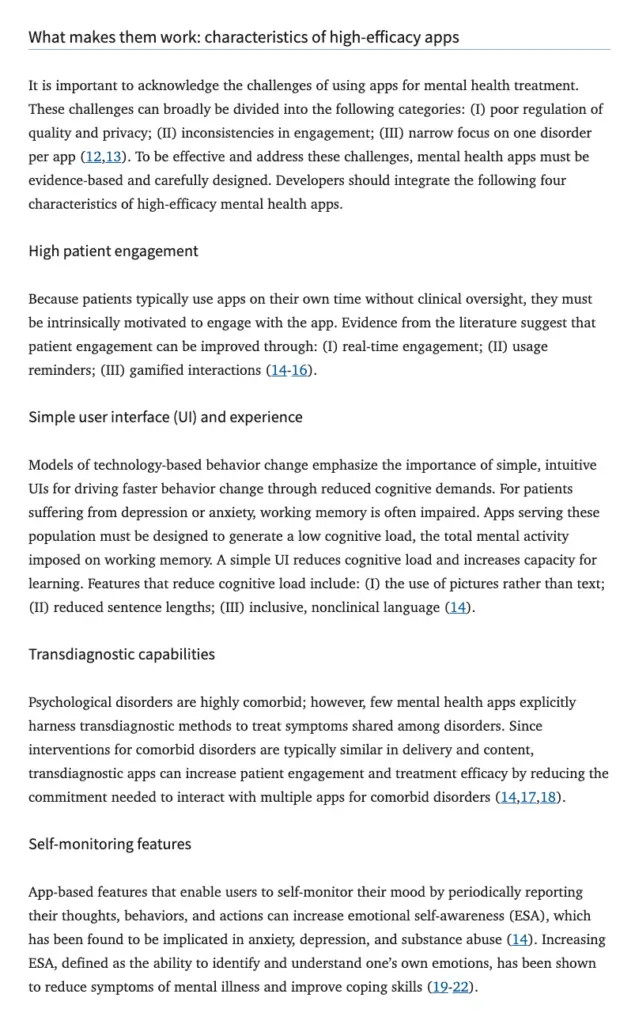
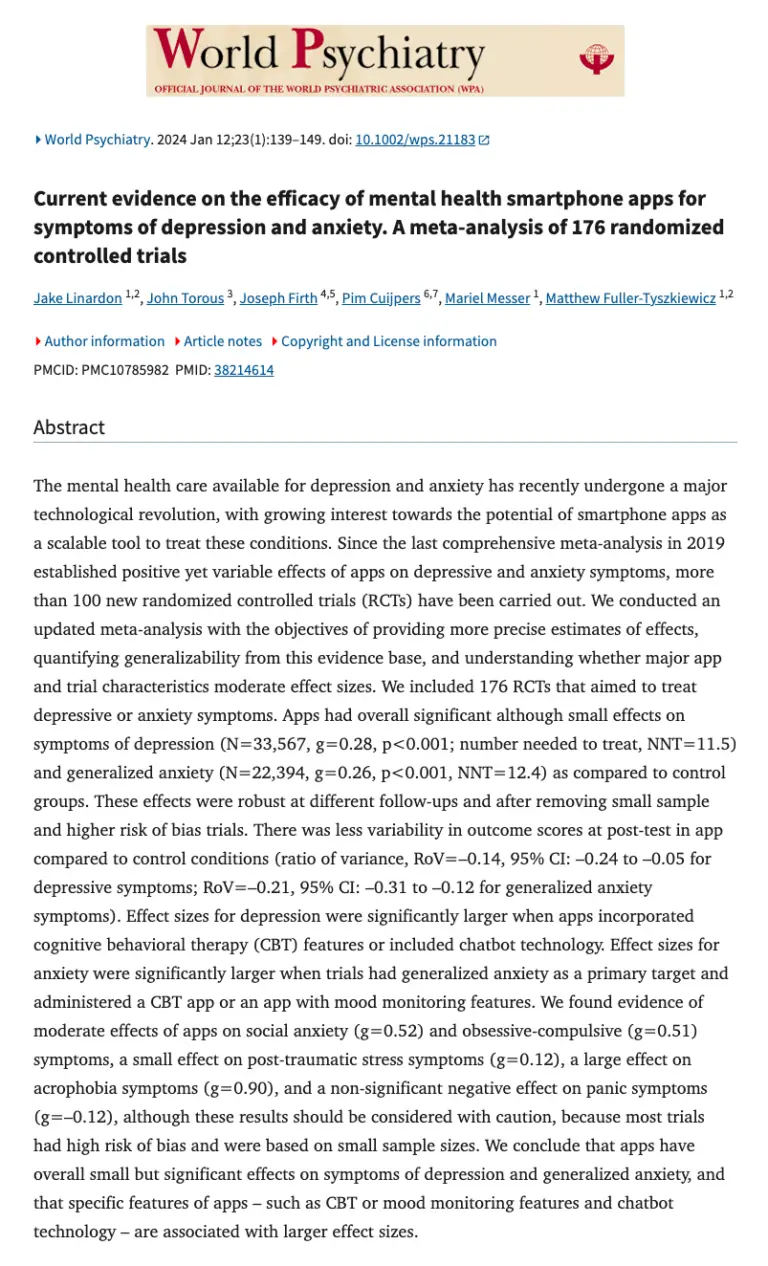
Summary Findings
- “…specific features of apps — such as CBT or mood monitoring features and chatbot technology — are associated with larger effect sizes”
- Users with major depression saw the least benefit in meta analysis of controlled trials
Competitive Usability Review
DBT Coach: Guided Therapy
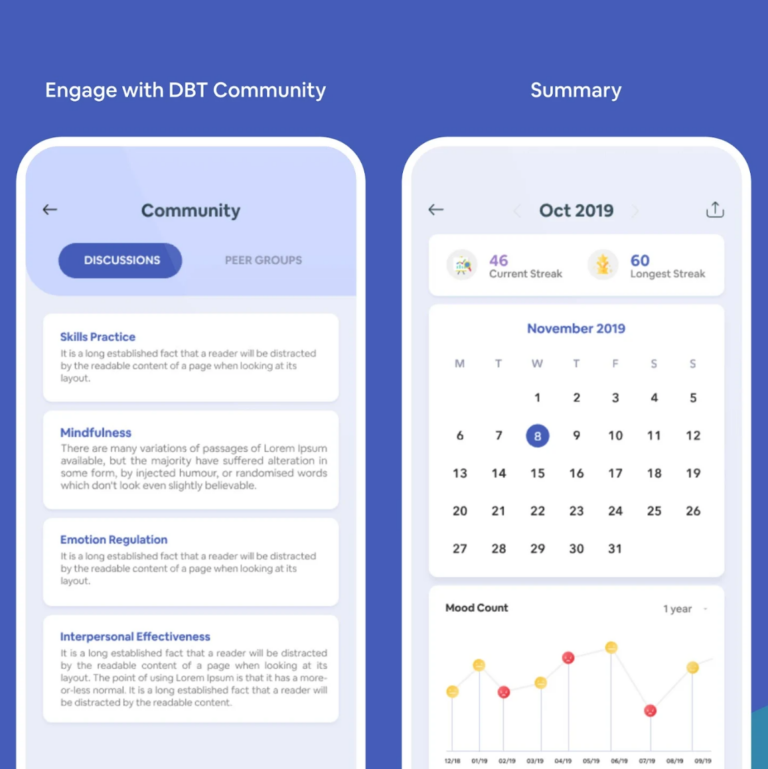
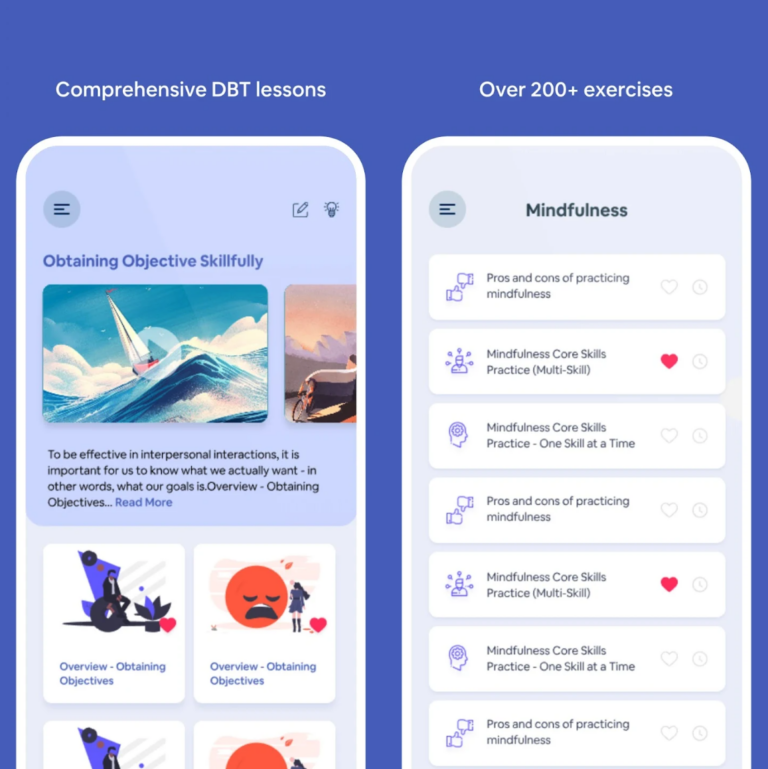
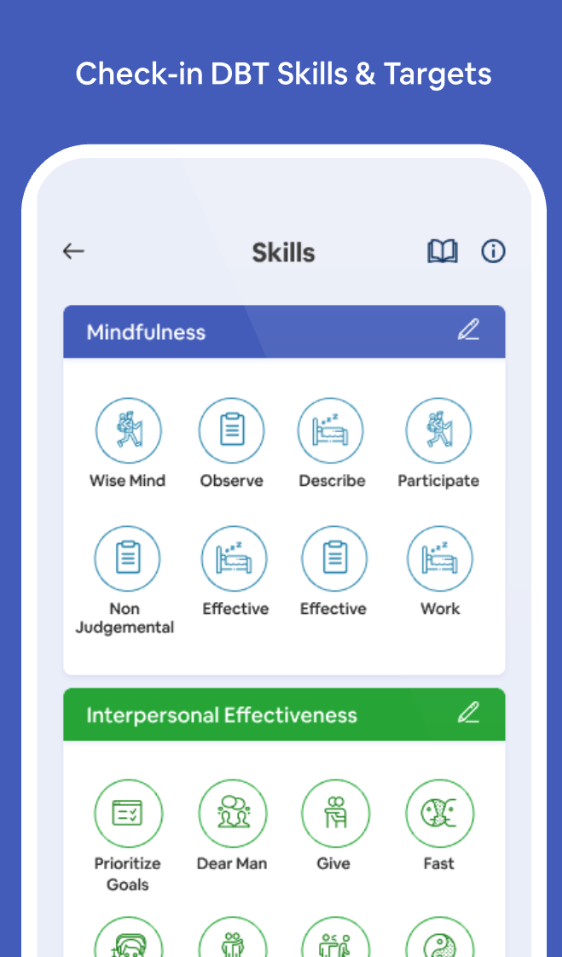
Key Features
- Daily Diary Card – general emotion/behaviour tracking
- mood (general)
- DBT skills used
- emotions (specific)
- problem behaviours
- helpful activities
- journal (freeform)
- Video lessons – How to do skills
- Skills test – fill in blanks to test knowledge, respond to prompting questions on topics related to therapy
- Extensive catalogue of mindfulness and breathing exercises
- Subscription: $11.99/month or $59.99/6 months
Experts Weigh In
PROS
- Daily notification to complete diary card
- Community discussion board connected to app
- Lots of learning material
- Add photo to journal
- Create a nuanced plan of action
- Worth the price to learn DBT
- FREEmium available
CONS
- FREEmium – less than 50% diary card
- Tracking form is overwhelming and dense for daily tracking
- “Skills Used” rating system didn’t make sense to experts
User Pain Points
- Unresponsive developer
- Poor customer service
- Overpriced
- Poor quality audio recordings
- Grammatical errors throughout the app
- FREEmium doesn’t offer enough for the app to be useful without paying
- Requests access to seemingly unnecessary filetypes
- Account deletion by request only
TAKEAWAYS
- Experts liked the amount of content available in the paid app, and they agreed that it was the leading DBT app that they reviewed
- Users had complaints about their experience with developers/tech support; quality control/quality assurance is important for fostering trust
- The freemium version has some great educational content and provides use of the diary card, but not enough substance to make the app worthwhile for users looking for reliable and dynamic tools to support the learning and practice of DBT
- The diary card is not that effective as it is – it felt overwhelming and distracting
- $60 / 6 months to use the material – minimum amount of time for effective administration of DBT
- Agreeable / appropriate use of notification (diary card, prompting action); respects focus
DBT Travel Guide
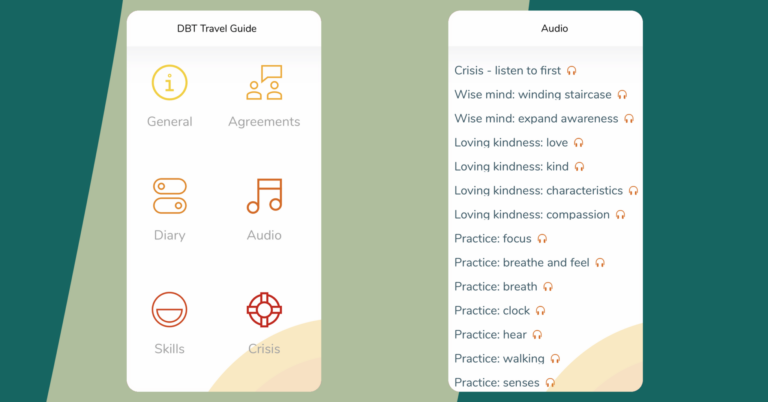
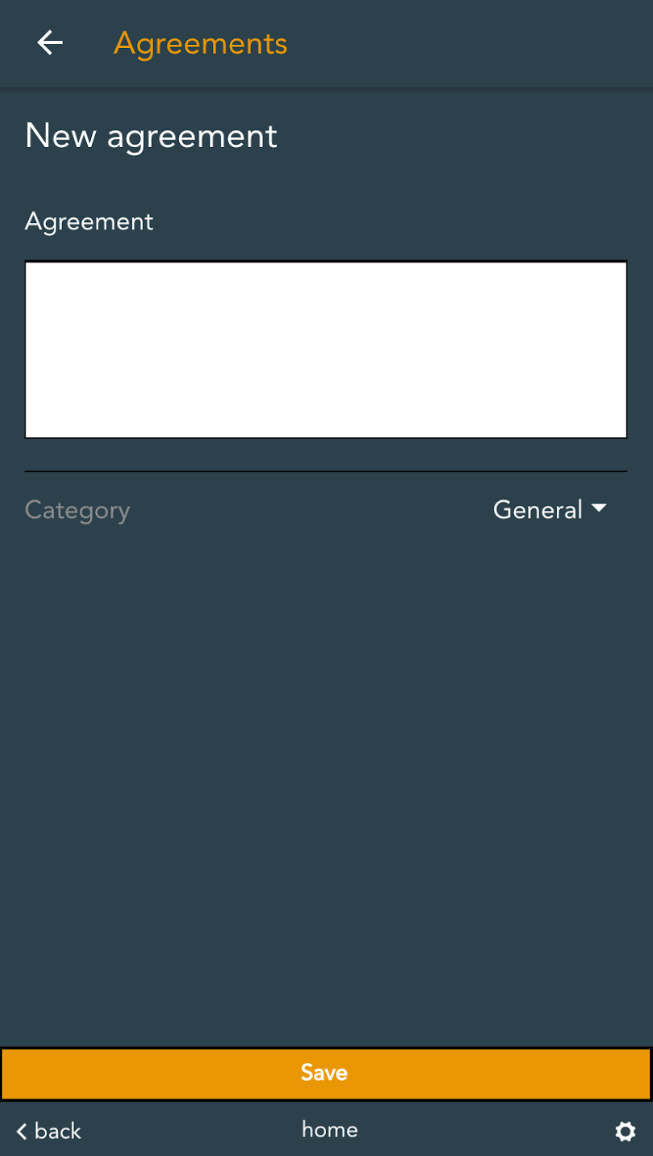
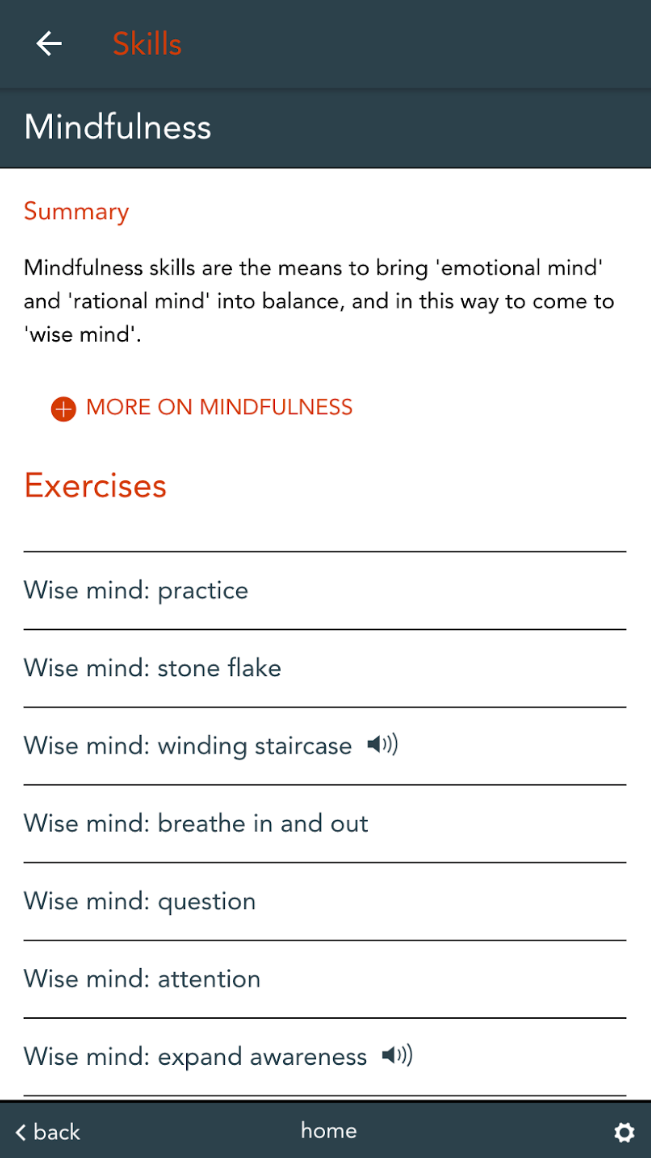
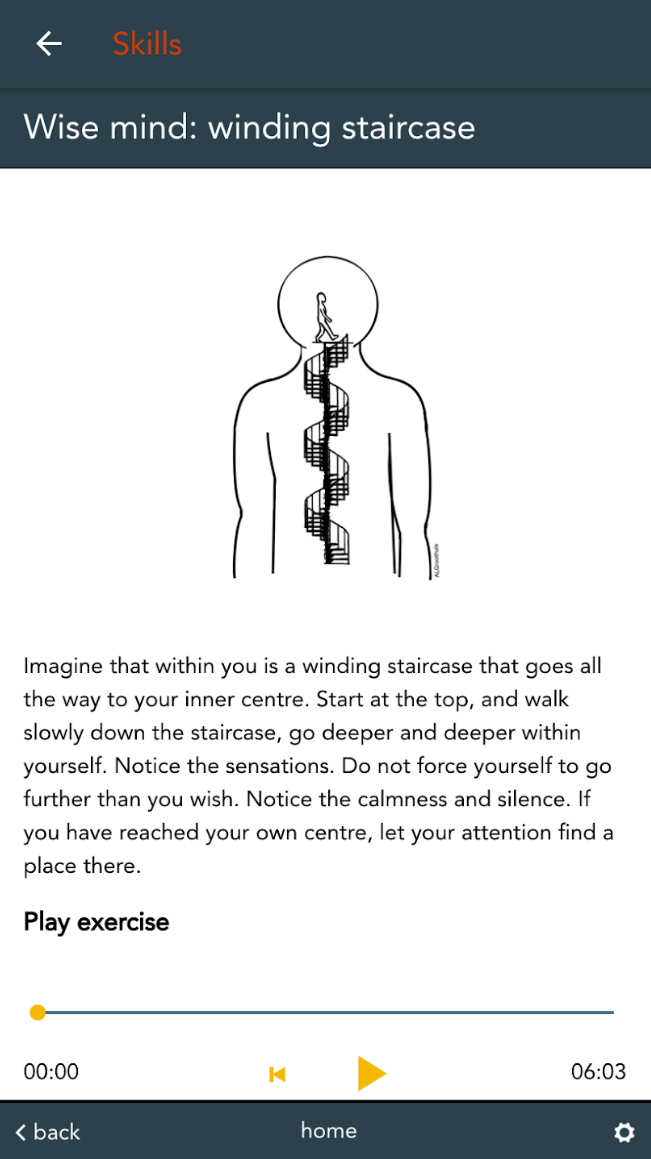
Key Features
- Daily Diary Card – sliding scales
- Audio and Video lessons
- Brief skill descriptions
- Crisis Triage; skill suggestions are passed to the user based on the specific issue they are dealing with in that moment
User Pain Points
- forms don’t autosave – users lost data by navigating away from diary card forms when navigating to other information in the app
- users felt that the app requested a lot of phone permissions that did not seem neessary; deterred some users from even using the app
Experts Weigh In
PROS
- diary card is easier to complete – interactive sliding scales are less overwhelming
- totally FREE
- some ‘ok’ meditations and basic info
CONS
- crisis feature is structured oddly; the colour seemingly intends to equate with the temp of the crisis; choosing the green option exits the feature screen; red instructs you to phone therapist; orange provides skill suggestions
- Language accessibility; app is Dutch-native, English is secondary language in app – creates limited accessibility in some areas where only dutch audio is available
- overall it lacks volume and depth of material
- skill explanations are basic and lack engaging dimension
- heavy focus on BPD connection – narrows too far in scope by singling out those users; DBT was developed with borderline patients in mind, but has grown in its scope of efficacy across other disorders of mood and emotion regulation
TAKEAWAYS
- This app is not all bad, but it lacks both in volume and depth of material; It lacks the substance for deeper learning of DBT.
- The app felt dated to experts: they pointed out that the language used is from a previous iteration of DBT from two decades ago; the therapeutic lexicon and format has changed with some significance since DBT was first created
- A simpler diary card made checking-in more palatable than DBT coach. what is the ultimate goal of the diary card in the task of learning or practicing DBT skills?
- the crisis button is interesting in concept; the most useful part about it is the system for triaging the level of crisis and suggesting skills based on a fairly simple cascading assessment; the prompts are easy enough to understand quickly, and they point the user towards appropriate skills.
- However, once the user reaches the skill summaries, they lack options for engagement that could bring the skill into better focus for the user.
- For EFFECTIVELY, we’ll rework the Crisis Triage feature applying what works: a function allowing users to quickly navigate through the catalogue of skills that may be most useful during an acute crisis or symptomatic episode
- We’ll improve the feature by adding actionable/interactive skill applications for the user to engage with in-app
Feature AuditING
DBT Travel Guide: Crisis Triage Feature
DBT Travel Guide has a stand-out feature for triaging the user’s level of crisis or emotional overwhelm.
It’s a strong concept, but the execution has room for improvement. We conduct a feature audit using activities including journey mapping and auditing the information architecture.
- Pinch to zoom in and out
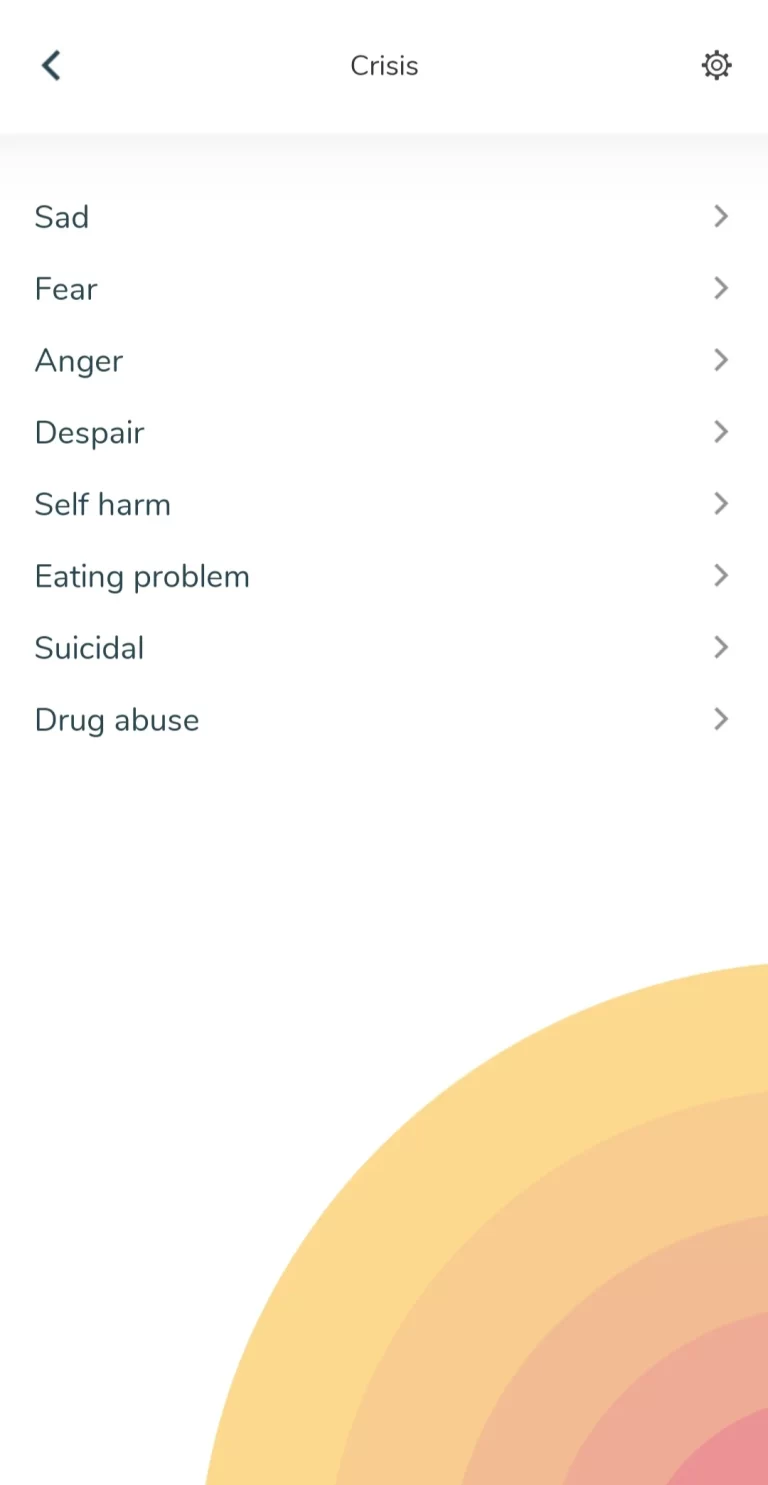
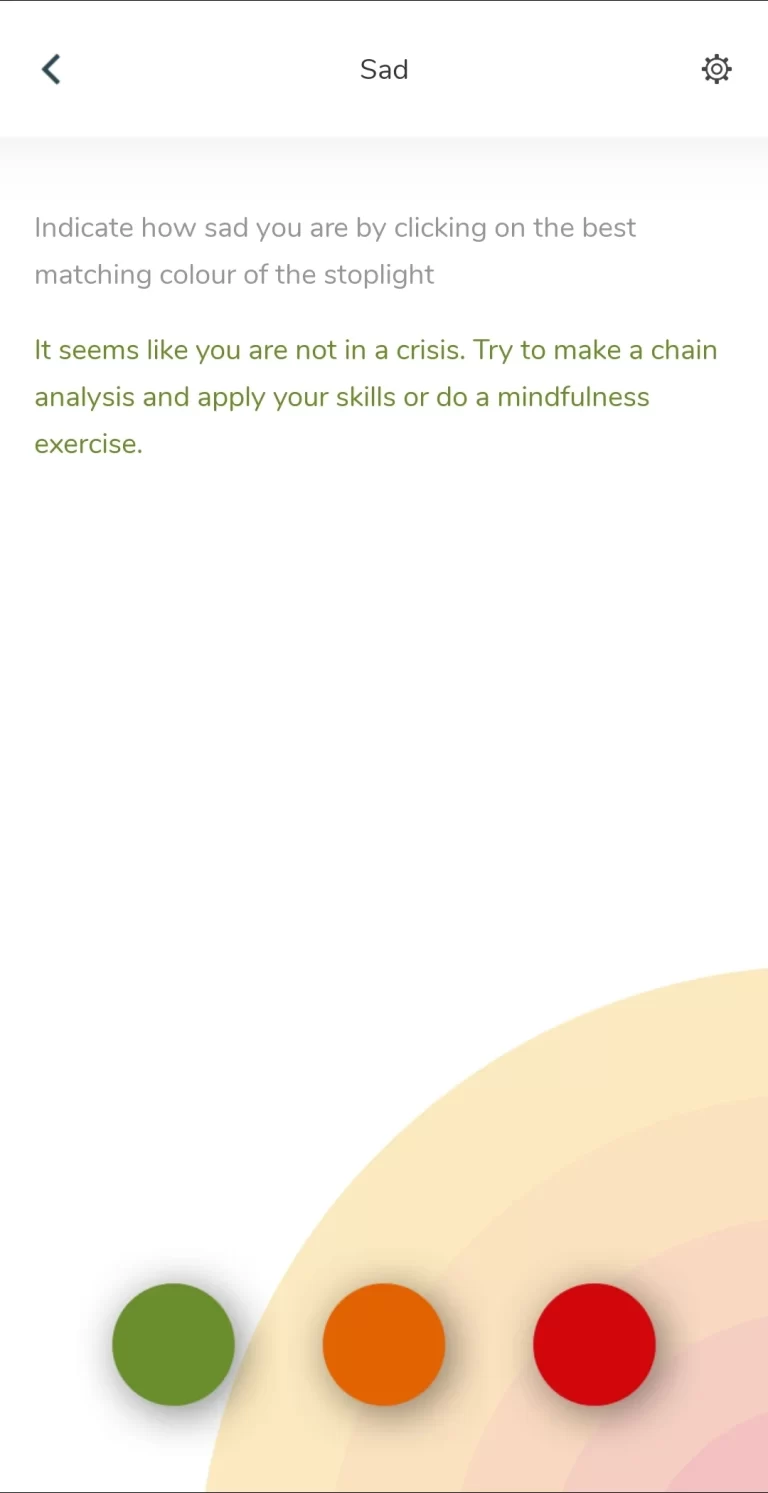
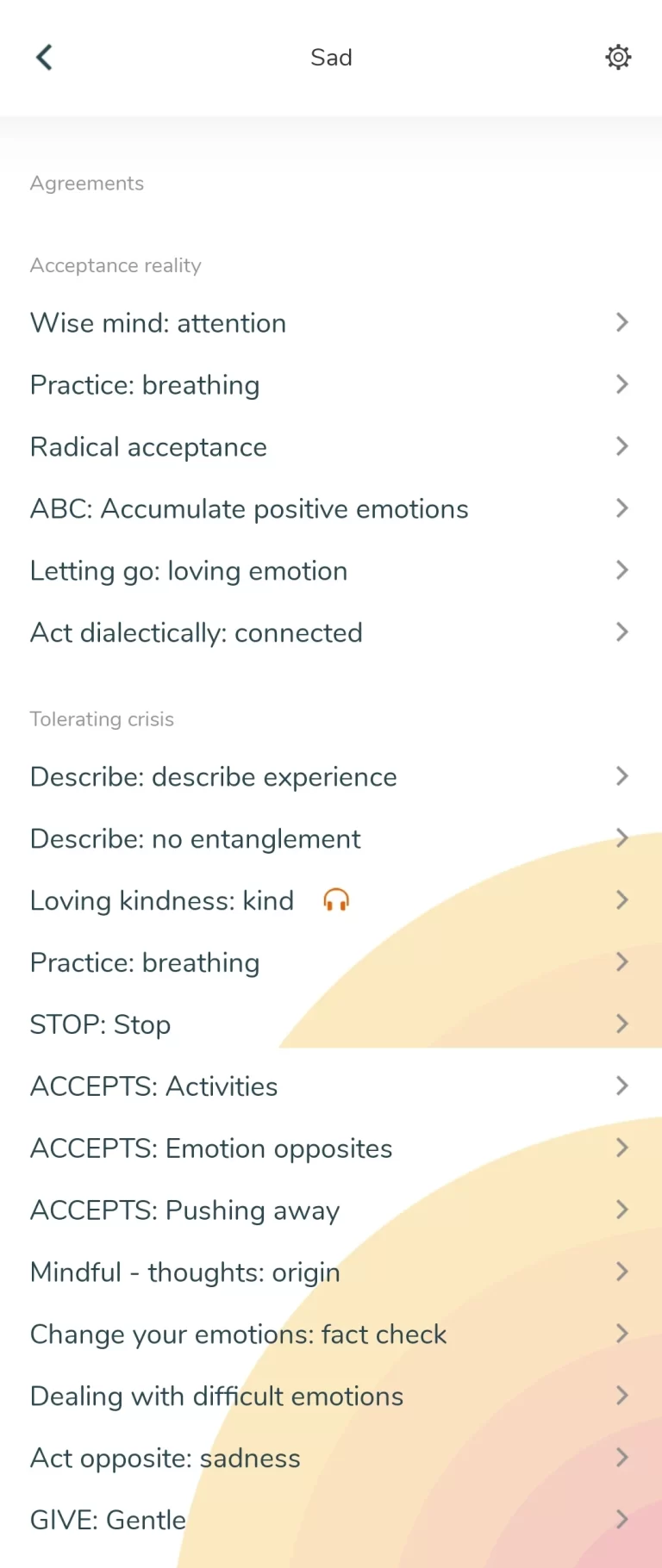
Screen 1: Type of Crisis, Screen 2: Severity of Crisis, Screen 3: Suggested Skills
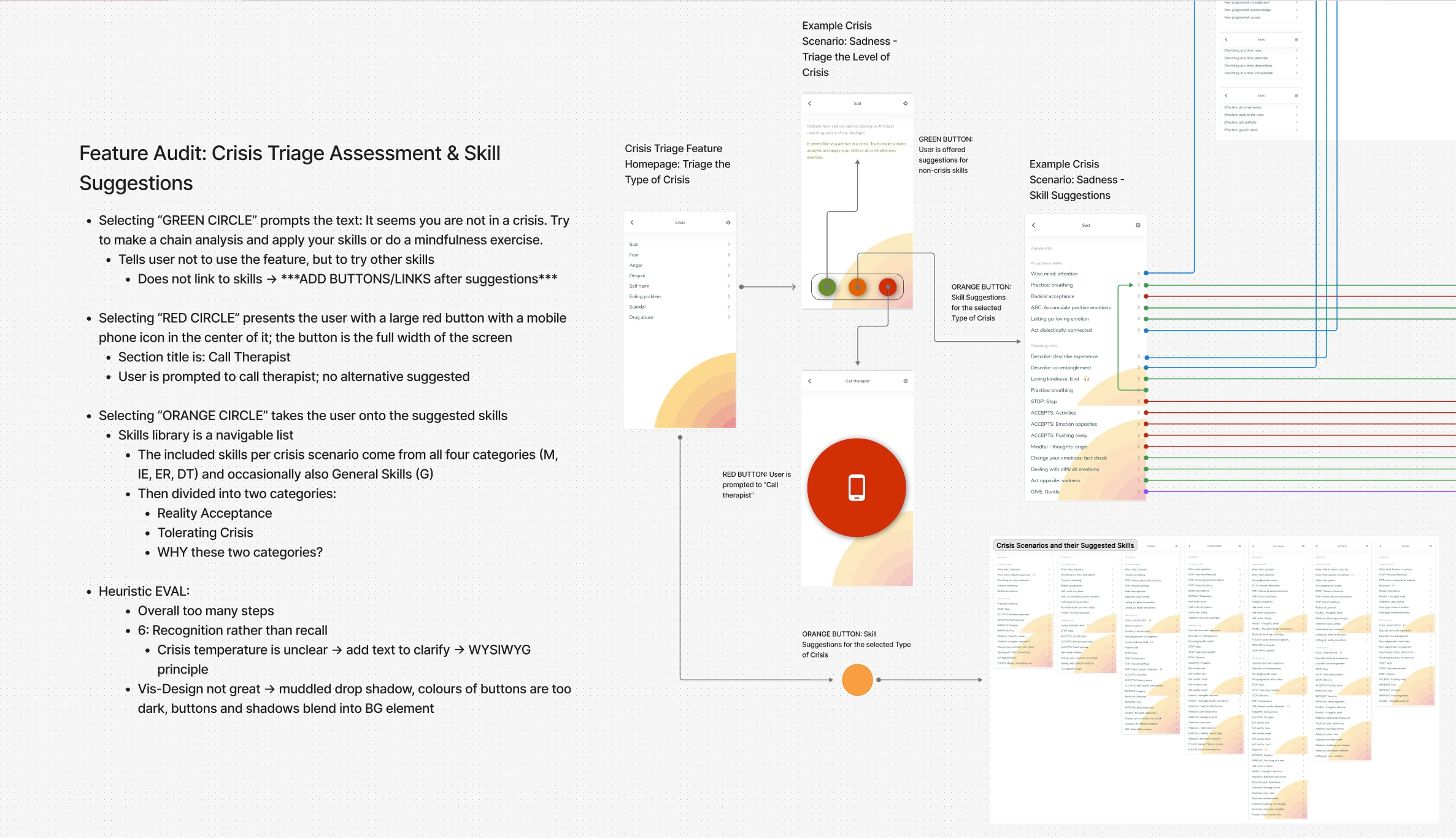
Artefact Production: Journey mapping and exposing feature architecture, annotating functionality, visually sorting and grouping data.
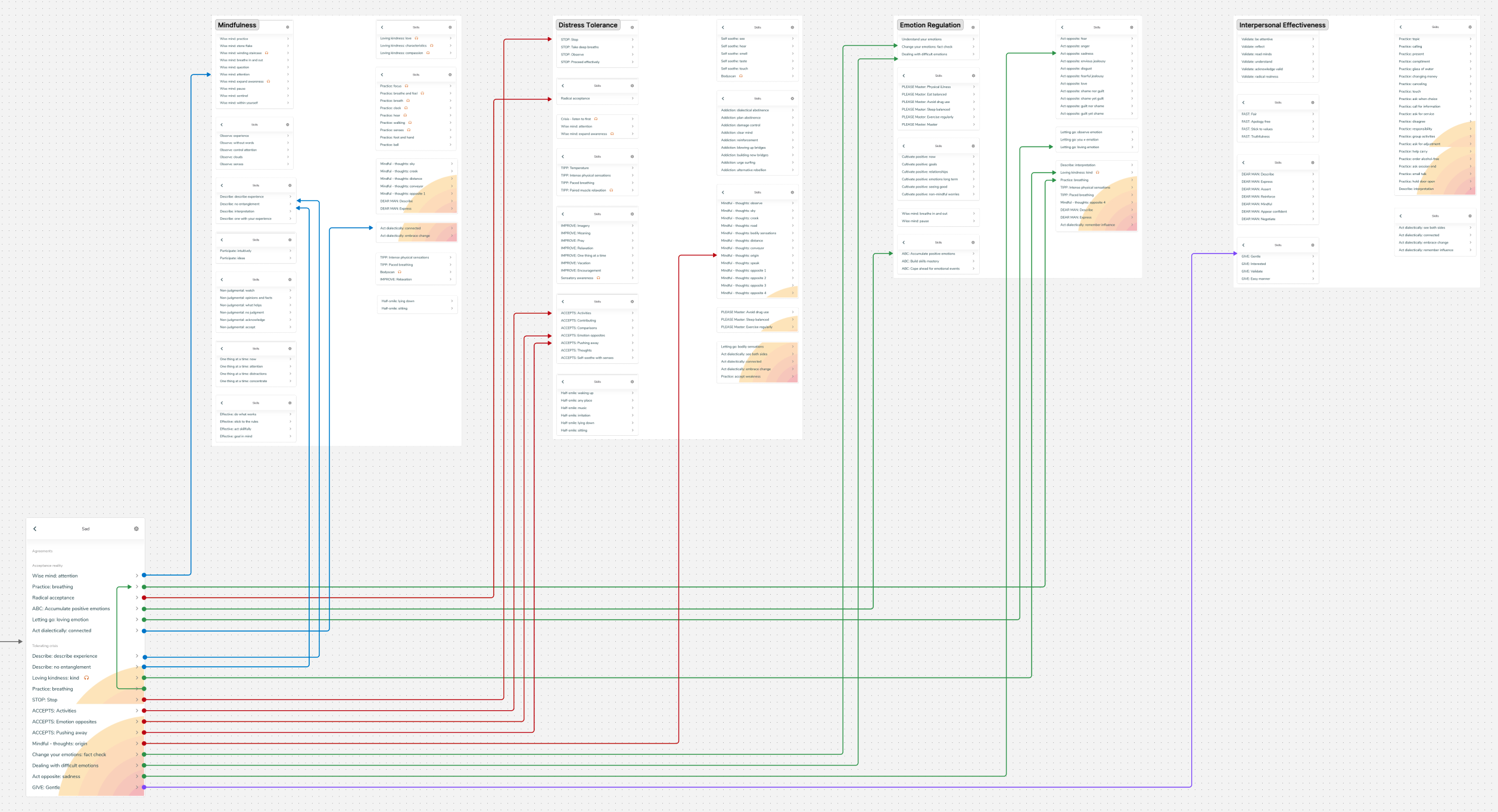
Artefact Production: Mapping relationship between crisis scenarios and suggested skills; ordering listed skills into subcategories within mains.
Feature Analysis
DBT Travel Guide – Crisis Triage Feature
- DBT Travel Guide breaks down the modular components of worksheets out into their own individual pages; it would reduce page redundancy to regroup these morsel-sized skill bites into their complete pages as they are presented in the DBT Workbook.
Consideration:
- In a crisis, receiving skills in bite-sized components may be better-calculated for users experiencing emotional distress in the moment.
- Emotional distress is often accompanied by diminished ability to process detailed information; the details of a mobile form prompting focused interaction from the user may be too nuanced during acute episodes of overwhelm.
When a user is in crisis:
- Keep things as simple as possible
- Focus on delivering the most useful content effectively
Future Steps:
- Systematically review skill sheets and create a paper component library
- A/B test multiple UX flows, content types and content density to find the preferred and most effective architecture and content strategy
Architecture/Structure:
- The smaller Component Skills as presented in DBT Travel Guide will be parented to the full Skill Sheets. When users are practicing a skill for the week, either the full Skill Sheet, or the smaller Component Skills can be added as Elements to the Card.
- Component Skills that make up the Skill Sheets can be re-used in our version of the Crisis Triage feature as interactive components that occupy the mixed skill lists of the feature.
Summary Findings
Therapy-Specific
Focus is on delivering high-quality content for learning and practicing DBT.
Prioritizes delivering the material on a schedule reflecting the institutional approach.
Nuanced Tracking
Specific skills call for specific kinds of tracking.
Tracking in DBT takes on different formats depending on the skill in focus.
Usability Matters
Users lost trust with apps that suffered from issues of content quality and functionality.
Product roadmap should integrate long-term technical support. Highly active support occurs during the first year or more following release.
Affordability Matters
Price reflects market competitors like Headspace, without alienating users with a high subscription cost like DBT Coach.
Mass licensing for publicly funded instituions and private practices.
Design & Delivery
User Persona

Claire
Get To Know Claire
Age: 29
Occupation: Bartender, Carpenter
Interests: Getting cozy with the cats; sketching plants & people; camping in National & Provincial parks; rock climbing
She often deals with overwhelming feelings of inadequacy and shame despite outward success at the ventures that she pursues. She has a tendency to jump between projects, and loses hours scrolling and researching topics that matter to her.
She is described as outgoing and has some close and longtime friendships, but she often struggles to connect more deeply for fear of being rejected by friends or partners if she is honest about how she feels.
She is sometimes described by those nearest to her as “hot and cold”; either full of energy and joy or experiencing inexplicably dour sadness.
Today, Claire knows she is not living optimally. The overwhelm that she experiences most intensely in private leaves her feeling anxious and detached.
Several months ago, she confided to a social worker at a community healthcare clinic what she has been experiencing in private. The healthcare worker was a graduate of a DBT program themselves before going on to pursue social work. They are able to get Claire on a waitlist for a nearby clinic and provide her with some interim support.
Several months have passed and Claire is about to begin DBT. She receives an orientation email before the group begins. The introductory materials often reference “homework”, igniting fresh fears in Claire; she struggled to complete homework outside of class throughout the majority of her scholastic career.
Let’s explore how EFFECTIVELY can support Claire on her journey through the study and application of DBT.
Onboarding Flow
- Pinch to zoom in and out
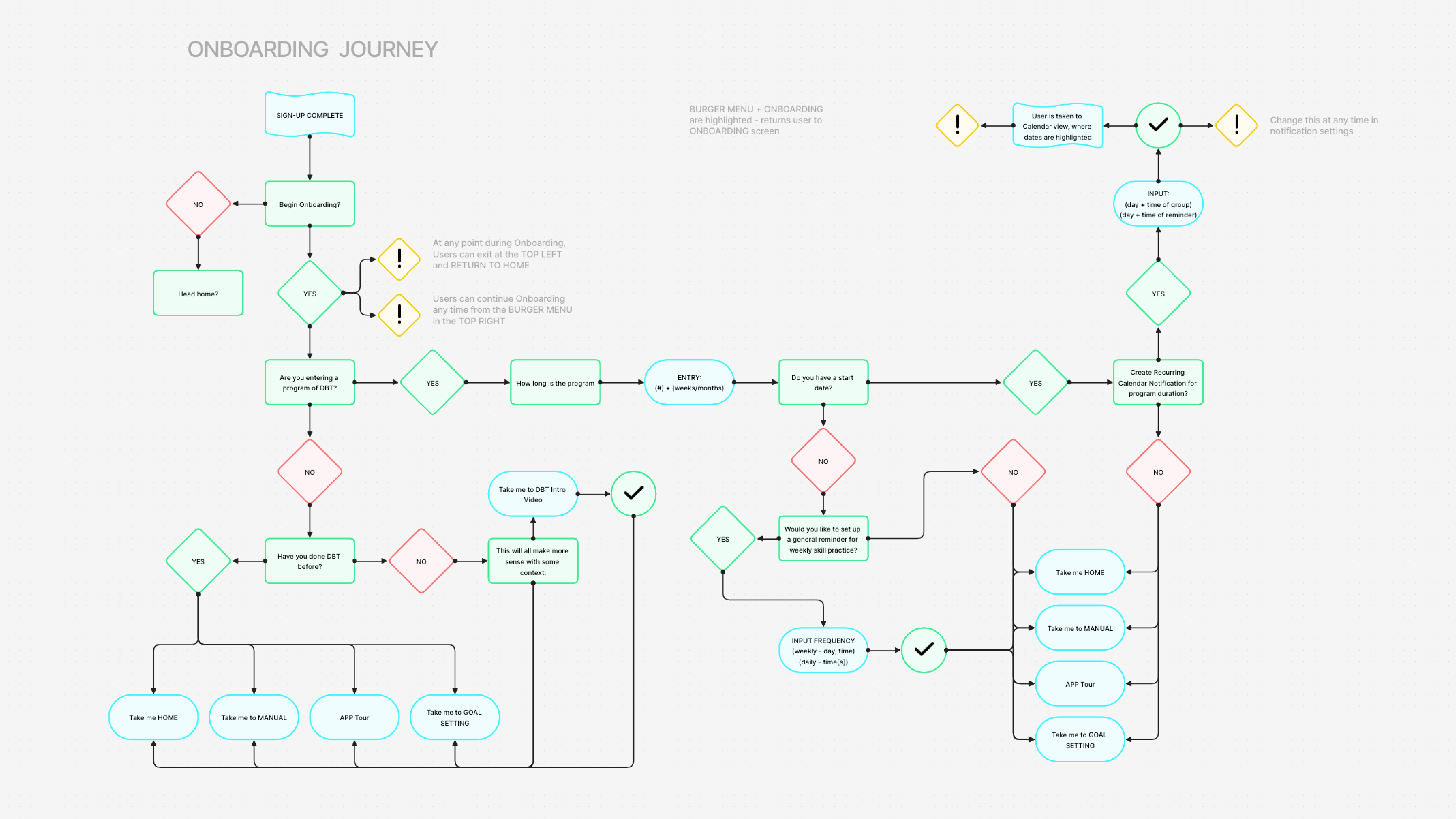
Artefact Production: Architecture of the onboarding journey represented as a flow
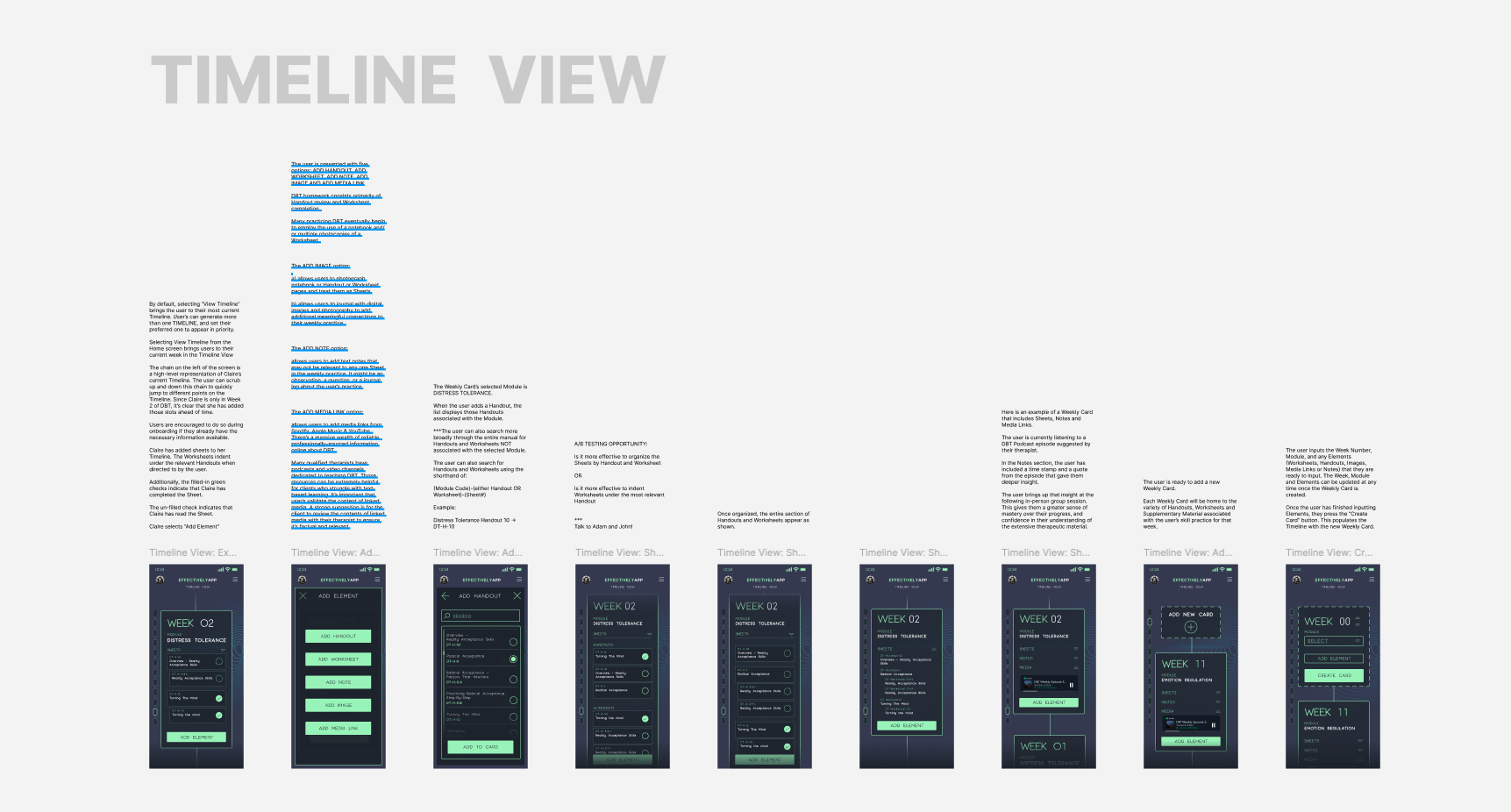
Artefact Production: Screen flows and written synopsis of the Timeline’s Card architecture; users add Elements to Cards; Cards are flexible—by default, one Card represents one week of study and practice; however, users have the flexibility to group Elements onto Cards as they choose
User Journey
After sign-up, Claire begins the Onboarding process: she watches the DBT Introduction Video. The clear takeaway is the organization of DBT into four modules.
She inputs her start date & program duration. The Calendar View populates with a repeating weekly appointment for the duration of those six months.
She skips the Notification Frequency & Goal Setting for now. She moves on to the Timeline View and Skill Card tutorials.
Claire is invited to complete a survey:
“Which of these skills sounds most helpful?”
Claire takes time to skim the collection of skills, & selects some that stick out to her.
A prompt appears, giving Claire the option to populate the Timeline with the selected skills. She selects “yes”.
The Timeline View is now populated with eight skills that Claire has selected.
Effectively suggests some other skills to compliment the ones that Claire has chosen; she adds those suggestions.
Claire now has a timeline consisting of twelve DBT skills.
Claire toggles the List View, which makes all twelve skills on the timeline visible at a high level. She toggles back to Card View, which expands each of the twelve Cards on the Timeline.
Generative Flows & Tables
- Pinch to zoom in and out
Feature Summary
Tap the Boxes to Expand or Collapse the Section
TIMELINE VIEW
- Plan therapy in advance
- Tailor the card's elements to your needs
- Document your progress to create your personal DBT skill guide
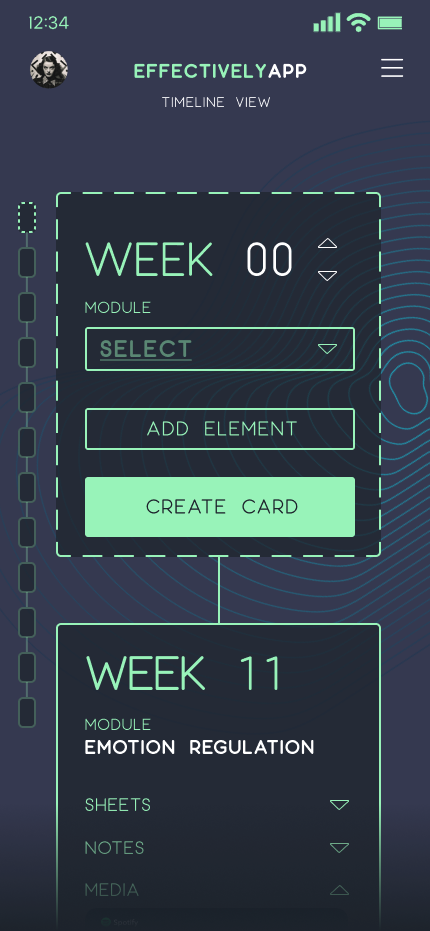
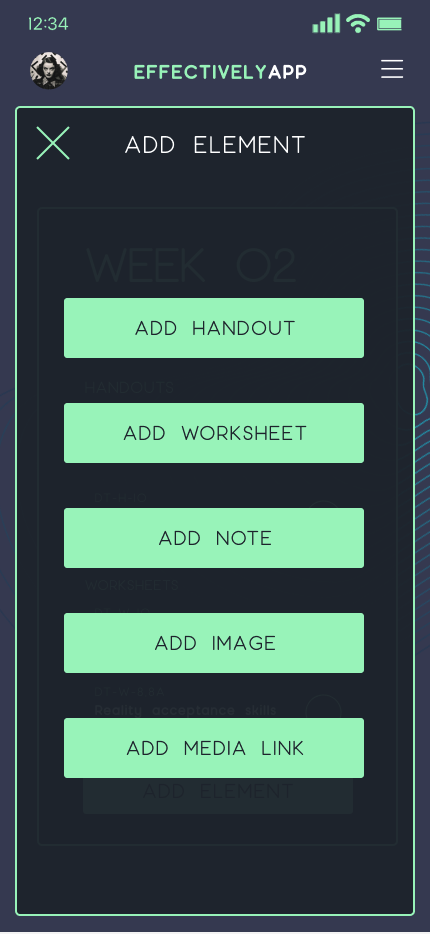
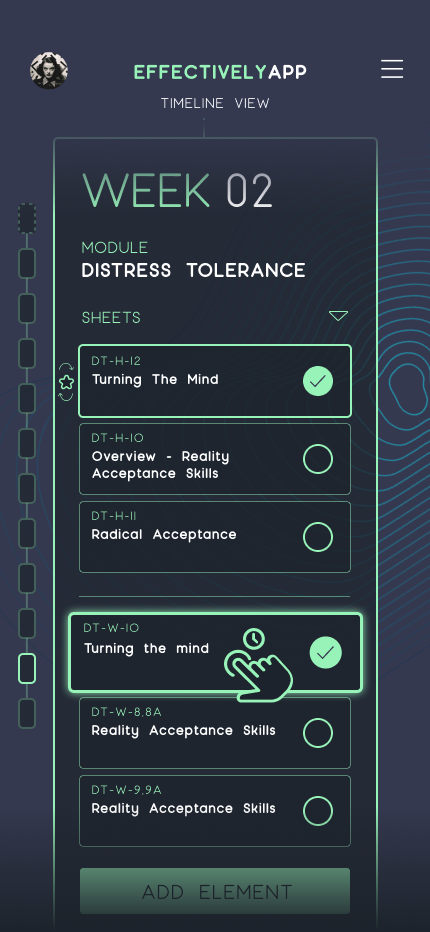
CALENDAR VIEW
- Three levels of view: monthly, weekly and daily
- Easily connect with popular calendar app of your choice: Google, Apple, Microsoft
- Schedule reminders, when and how you want them with customizable push notifications
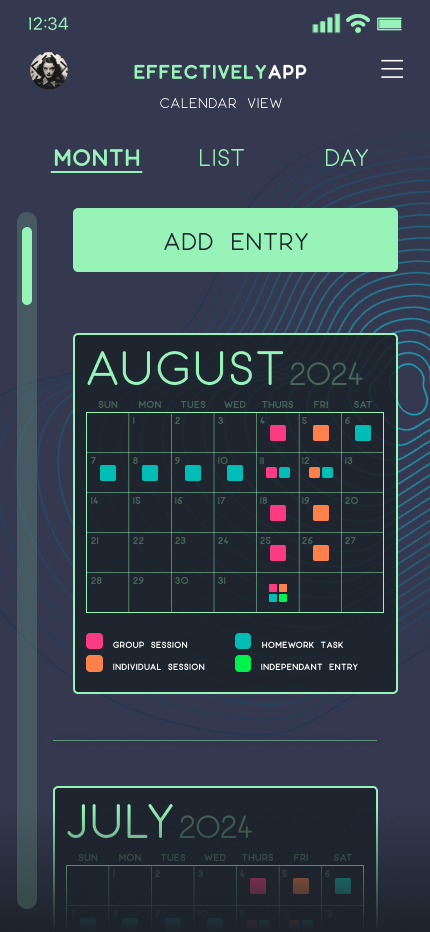
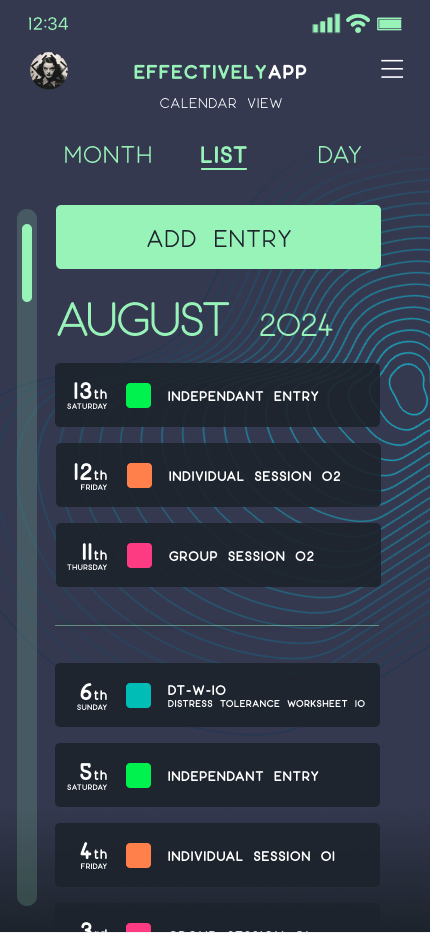
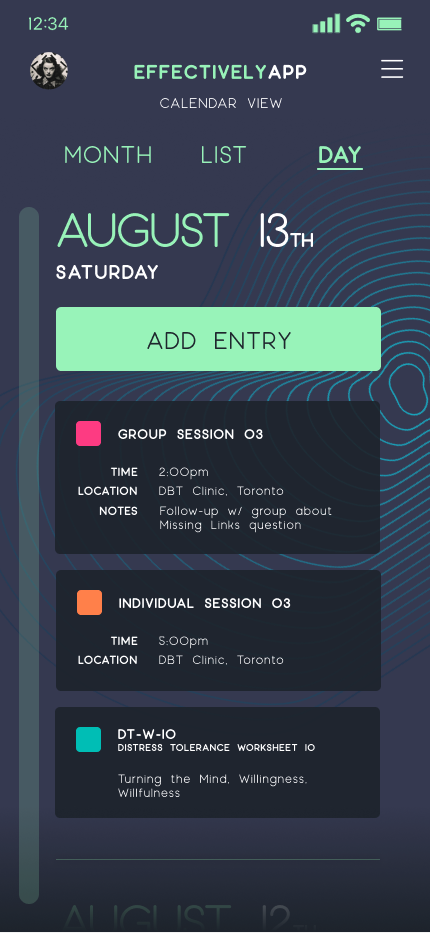
HANDOUTS + WORKSHEETS
- Easily access the skills manual containing the Handouts and Worksheets
- Sheets are designed mobile-first; no glitchy forms
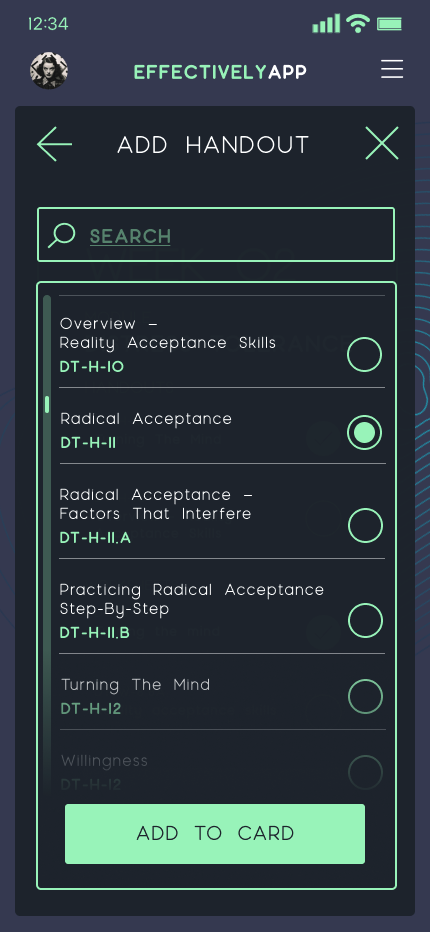

ENRICHED CONTENT
- Linked content in the form of articles, videos and podcasts provide variable options for engaging with therapy materials.
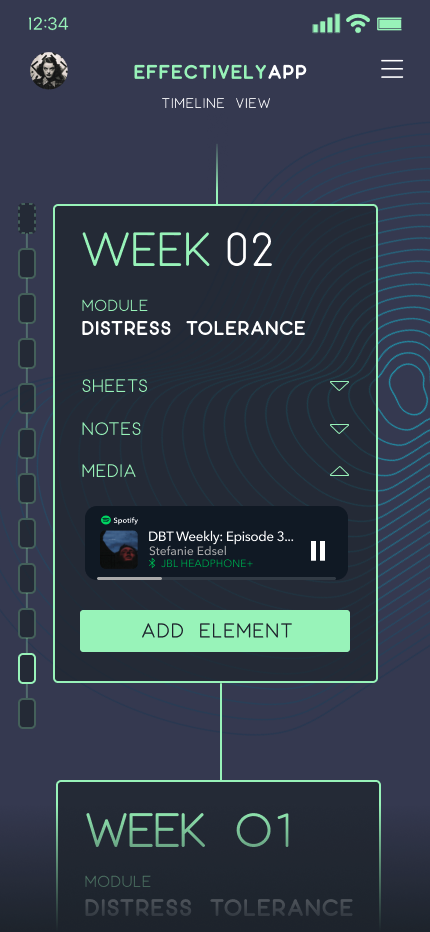
Blogs
- Deconstructing The Imposter Within [Part I] — Impostor Syndrome, Futureshock & Personal Creative Expression
- Deconstructing The Impostor Within [Part II] — Expanding Oz & Effectively: The DBT App
- Deconstructing The Impostor Within [Part III] — A Five Step Plan For Resolving Feelings Of Impostor Syndrome
- Expanding Oz: Finding Inspiration For Dorothy In The Life Of James Tiptree Jr. AKA Alice Bradley Sheldon